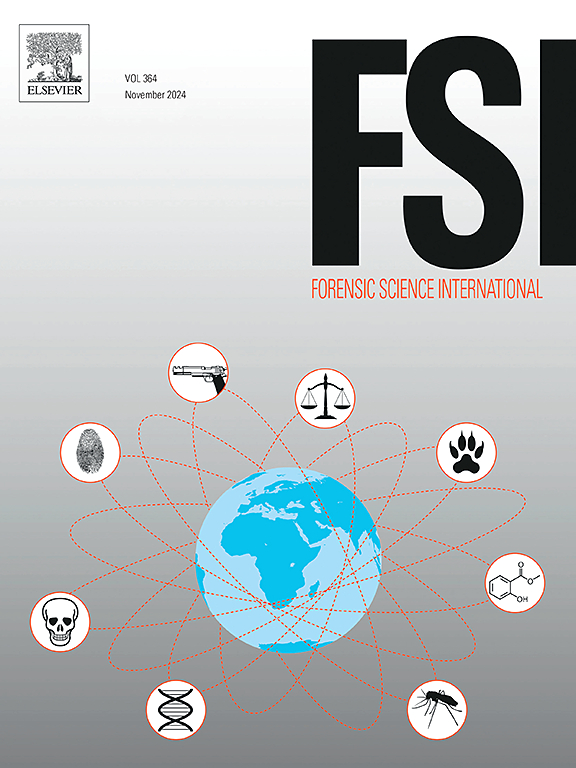From confiscation to conservation: Wildlife DNA forensic for species identification of confiscated Felidae in Indonesia
IF 2.2
3区 医学
Q1 MEDICINE, LEGAL
引用次数: 0
Abstract
Illegal wildlife trade poses a significant threat to Indonesia’s biodiversity, especially among its diverse Felidae species (cats). While molecular methods have proven effective for identifying some Felidae species, there remains a gap in comparing these techniques across different endemic Felidae species in Indonesia, particularly in cases involving multiple species in confiscated wildlife products. This study applies DNA forensic techniques to analyze 38 confiscated Felidae samples, identifying four species: Sumatran tiger (Panthera tigris sumatrae), leopard (Panthera pardus), leopard cat (Prionailurus bengalensis), and clouded leopard (Neofelis nebulosa). Notably, 21 samples identified as Sumatran tigers showed 100 % similarity to the reference sequence, demonstrating the effectiveness of custom-designed primers. The analysis also revealed a diverse range of biological materials, supporting the robustness of DNA forensics in wildlife conservation. A Bayesian phylogenetic tree further confirmed species differentiation with strong bootstrap values. These findings underscore the importance of accurate species identification for prosecuting wildlife crimes and formulating targeted conservation strategies. Despite limitations, including sample size and reliance on existing reference data, the study emphasizes the crucial role of DNA forensics in combating illegal wildlife trade and highlights the need for improved genetic databases. Practical implications include establishing protocols for sample collection, DNA forensic training for law enforcement, and fostering collaboration between forensic laboratories and conservation organizations. Integrating these forensic techniques supports broader conservation goals by enabling targeted enforcement, effective prosecution, and informed conservation planning through accurate subspecies identification.
从没收到保护:印度尼西亚被没收Felidae物种鉴定的野生动物DNA法医。
非法野生动物贸易对印度尼西亚的生物多样性构成了重大威胁,特别是对其多样化的猫科动物物种(猫)。虽然分子方法已被证明对识别某些猫科动物物种是有效的,但在印度尼西亚不同的地方性猫科动物物种之间比较这些技术仍然存在差距,特别是在涉及多种被没收野生动物产品的情况下。本研究运用DNA法医技术对38份被没收的狐科样本进行了分析,鉴定出4种:苏门答腊虎(Panthera tigris sumatrae)、豹(Panthera pardus)、豹猫(Prionailurus bengalensis)和云豹(Neofelis nebulosa)。值得注意的是,21个被鉴定为苏门答腊虎的样本与参考序列的相似性为100 %,证明了定制设计的引物的有效性。分析还揭示了各种各样的生物材料,支持了DNA法医在野生动物保护中的可靠性。贝叶斯系统发育树进一步证实了物种分化具有很强的自举值。这些发现强调了准确的物种识别对于起诉野生动物犯罪和制定有针对性的保护策略的重要性。尽管存在一些限制,包括样本量和对现有参考数据的依赖,但该研究强调了DNA取证在打击非法野生动物贸易中的关键作用,并强调了改进遗传数据库的必要性。实际意义包括建立样本收集协议,为执法提供DNA法医培训,以及促进法医实验室和保护组织之间的合作。整合这些法医技术,通过精确的亚种鉴定,实现有针对性的执法、有效的起诉和知情的保护规划,从而支持更广泛的保护目标。
本文章由计算机程序翻译,如有差异,请以英文原文为准。
求助全文
约1分钟内获得全文
求助全文
来源期刊

Forensic science international
医学-医学:法
CiteScore
5.00
自引率
9.10%
发文量
285
审稿时长
49 days
期刊介绍:
Forensic Science International is the flagship journal in the prestigious Forensic Science International family, publishing the most innovative, cutting-edge, and influential contributions across the forensic sciences. Fields include: forensic pathology and histochemistry, chemistry, biochemistry and toxicology, biology, serology, odontology, psychiatry, anthropology, digital forensics, the physical sciences, firearms, and document examination, as well as investigations of value to public health in its broadest sense, and the important marginal area where science and medicine interact with the law.
The journal publishes:
Case Reports
Commentaries
Letters to the Editor
Original Research Papers (Regular Papers)
Rapid Communications
Review Articles
Technical Notes.
 求助内容:
求助内容: 应助结果提醒方式:
应助结果提醒方式:


